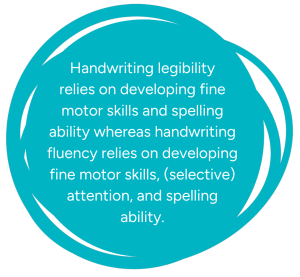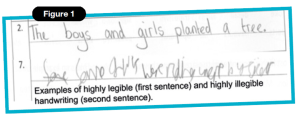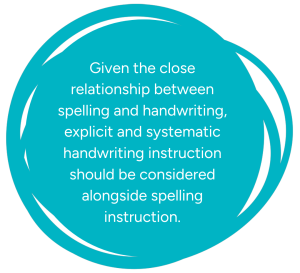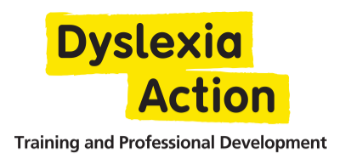How does handwriting relate to other key developmental skills?
Lucy Howes
Cameron Downing is a Senior Lecturer at Leeds Trinity University where he continues to build on his doctoral and postdoctoral work at Bangor University focusing on typical and atypical development of spelling and handwriting skills. This article was first published in The Dyslexia Guild Review Magazine (Volume 33(2) Autumn/Winter).
Introduction
Handwriting continues to be an important skill for children to use to communicate their knowledge in the classroom. It also remains an important component of wider literacy development. Furthermore, handwriting difficulties are often reported amongst people with dyslexia. Despite the importance of handwriting, there has been relatively little effort to understand handwriting development compared to reading and spelling. In this article, I explore what recent research tells us about handwriting and its relationship with other developmental skills, and what this means in school.
Why focus on handwriting?
In an increasingly technology filled world, handwriting is often superseded by typing or texting in our daily lives. Perhaps unsurprisingly schools around the globe are increasingly moving away from providing handwriting instruction. However, being able to write legibly and fluently are critical skills for children. In school, handwriting remains the primary method of communicating our knowledge, and illegible and/or slow handwriting are cited as the most common reasons for children’s referral to occupational therapy. Handwriting is also important for literacy development too. Recent work has shown that learning to write letters is likely to help children build letter knowledge (Wiley & Rapp, 2021), a critical skill for later reading development. Furthermore, development of handwriting has long been linked with later writing quality.
What do we mean when we talk about handwriting?
We often think of handwriting as a single skill or ability. However, research is increasingly demonstrating that we should consider handwriting as two separate skills: fluency and legibility. Handwriting fluency is our ability to write text at speed without hesitation or too much effort, whereas handwriting legibility is our ability to write words which are decipherable by the reader. Evidence that fluency and legibility are separable skills comes from findings of different rates of development. Whilst handwriting fluency increases through childhood, often handwriting legibility reaches a peak and plateaus much earlier (Gosse et al., 2021).
Given that handwriting is likely made up of two separate skills, it is important then that we can measure both fluency and legibility. Handwriting fluency is straightforward to measure objectively and tests such as the Detailed Assessment of the Speed of Handwriting (DASH) have long been used effectively in practice. Handwriting legibility, on the other hand, is much trickier to measure objectively and relatively fewer well-validated and reliable tests of legibility exist. However, two recent tests include the Handwriting Legibility Scale (HLS) by Barnett et al. (2018) and our own Spelling and Handwriting Legibility Test (SaHLT, Downing & Caravolas, 2023a) which measures both spelling accuracy and handwriting legibility. The lack of high-quality tests of handwriting fluency and legibility has been a major issue in trying to understand the development of handwriting skills and its relationship with other skills important for development such as spelling, fine motor skills, and attention (see Figure 1).

How does handwriting relate to other skills?
Despite the importance of handwriting in school and for development, relatively little is known about how handwriting fluency and legibility relate to other important developmental skills. There are varying accounts of how spelling, fine motor skills, and attention may be related to either or both handwriting fluency and handwriting legibility. A potential relation between these skills is also evidenced by the often-reported findings of handwriting difficulties in individuals with dyslexia, developmental coordination disorder or dyspraxia, and attention deficit hyperactivity disorder (ADHD). So, in a recent study (Downing & Caravolas, 2023b), from a project funded by the Waterloo Foundation, we aimed to examine how spelling, motor skills, and attention may be related to both handwriting fluency and legibility across a large sample of primary-aged children. To do so, we asked children aged between 8 and 10 years old to complete tests of spelling, fine motor skills, and (selective) attention as well as the DASH to measure handwriting fluency and the SaHLT to measure handwriting legibility.
Considering handwriting legibility first, we found fine motor skills were most strongly related to legibility, followed by spelling ability. This means that children who have well-developed motor skills and good spelling ability are more likely to write more legibly. Conversely, children with poorer motor skills and/or spelling ability are less likely to write legibly. Interestingly, we found that children’s attention abilities did not seem to be related to their handwriting legibility.
Considering handwriting fluency next, we found that spelling, fine motor skills, and attention were all related to fluency. However, the pattern of these relations differed to their relations with handwriting legibility. Spelling was more strongly directly related to handwriting fluency than fine motor skills. This was the opposite to what we discovered for handwriting legibility. Interestingly, we also found that the relationship between children’s motor ability with handwriting fluency was influenced by their attention skills. In this study we measured children’s selective attention, which is their ability to focus on specific information or processes whilst suppressing other irrelevant information or processes. With this in mind, we believe that our findings show that children who are still developing handwriters use their attentional skills to focus specific fine motor skills to help them write fluently.
These findings together show children’s spelling, fine motor, and attentional skills are all related to their handwriting. These skills are all utilised to a different extent in handwriting fluency and legibility. That is, handwriting legibility relies on developing fine motor skills and spelling ability whereas handwriting fluency relies on developing fine motor skills, (selective) attention, and spelling ability. Whilst children of all abilities took part in this study, these findings help inform our understanding of handwriting amongst people with dyslexia and other specific learning difficulties (SpLDs).
Handwriting and dyslexia
We often see that people with dyslexia write less fluently and legibly. The findings from our study along with other studies help us understand why this might be. We now know that spelling is related to handwriting fluency and legibility. Indeed, other studies have shown that we write words less fluently when the word’s spelling is more complex (Kandel & Perret, 2015). Furthermore, certain aspects of handwriting legibility, such as how well we form letters (letter formation) are more strongly related to spelling skills.
This evidence suggests that spelling processes can directly influence our handwriting, particularly in children. In the case of dyslexia, where spelling difficulties are expected, we see that less fluent and less legible handwriting is primarily because of these spelling difficulties.
As we have seen, handwriting also relies on motor and attention skills. SpLDs are associated with difficulties with motor (e.g., Developmental Coordination Disorder (DCD)/dyspraxia) and attentional (e.g., ADHD) skills and so handwriting difficulties are also found amongst other SpLDs too. Importantly, though, we know that dyslexia frequently co-occurs with other SpLDs such as DCD/dyspraxia and ADHD (Downing & Caravolas, 2020; Gooch et al., 2011), which means that people with co-occurring dyslexia and other SpLDs are also likely to have handwriting fluency and legibility difficulties. In people with dyslexia and co-occurring DCD and/or ADHD, handwriting difficulties are likely to stem from spelling as well as motor and/or attentional difficulties, also.
What does this mean for practice?
We should consider what we know about handwriting in relation to assessment and intervention. Handwriting remains an important skill in education that is related to several other critical skills for school success (e.g., spelling) and so handwriting should be routinely measured in people who either have, or we think may have, dyslexia. As handwriting comprises handwriting fluency and handwriting legibility, it is important that both skills are measured routinely alongside other literacy skills using valid and reliable tests. Given that handwriting difficulties are found in other SpLDs which frequently co-occur with dyslexia, it is important that we consider the possible causes of handwriting difficulties. Specifically, whether these handwriting difficulties fit within a wider pattern of literacy difficulties and motor or attentional difficulties, also.
In addition to assessing handwriting, it is also important to target handwriting fluency and legibility difficulties as part of intervention work. Given the close relationship between spelling and handwriting, explicit and systematic handwriting instruction should be considered alongside spelling instruction. Compared to reading and spelling, relatively little research has focused on effective handwriting instructional techniques, although, the evidence does point to individualised instruction which focuses on different areas of handwriting being effective (Santangelo & Graham, 2016).
Although we increasingly type and text, handwriting remains a critical part of our development. The development of handwriting fluency and legibility is intertwined with the development of other key abilities such as spelling, fine motor skills, and attention. It is important we adequately measure handwriting fluency and legibility and develop effective instruction and interventions to ameliorate handwriting difficulties.
Take home messages:
- Handwriting remains a critical skill for school and development.
- Handwriting comprises fluency (handwriting at speed without hesitation) and legibility (producing writing which is decipherable).
- Spelling and fine motor skills are important for handwriting legibility.
- Spelling, fine motor, and attention skills are important for handwriting fluency.
- (Selective) attention likely aids in the control of fine motor skills when young handwriters are writing at speed.
- Developing, testing, and using effective evidence-based assessments and interventions for both handwriting fluency and legibility is critical.
To find out more about handwriting research, learn about the Spelling and Handwriting Legibility Test (SaLHT), or to get involved in current and future research projects please contact me via email: c.downing@leedstrinity.ac.uk
References:
Barnett, A. L., Prunty, M., & Rosenblum, S. (2018). Development of the Handwriting Legibility Scale (HLS): A preliminary examination of reliability and validity. Research in developmental disabilities, 72, 240-247. https://doi.org/10.1016/j.ridd.2017.11.013
Downing, C., & Caravolas, M. (2020). Prevalence and Cognitive Profile of Children with Comorbid Literacy and Motor Disorders. Frontiers in Psychology, 11, 573580. https://doi.org/10.3389/fpsyg.2020.573580
Downing, C., & Caravolas, M. (2023a). Evaluating the Spelling and Handwriting Legibility Test (SaHLT): a tool for the concurrent assessment of spelling and handwriting. Reading and Writing, 1-26. https://doi.org/10.1007/s11145-022-10402-2
Downing, C., & Caravolas, M. (2023b). Handwriting Legibility and Fluency and their Patterns of Concurrent Relations with Spelling, Graphomotor and Selective Attentional Skills. Journal of Experimental Child Psychology, 236, 105756. https://doi.org/10.1016/j.jecp.2023.105756
Gooch, D., Snowling, M., & Hulme, C. (2011). Time Perception, Phonological Skills and Executive Function in Children with Dyslexia and/or ADHD Symptoms. Journal of Child Psychology and Psychiatry, 52(2), 195-203. https://doi.org/10.1111/j.1469-7610.2010.02312.x Gosse, C., Parmentier, M., & Van Reybroeck, M. (2021). How do Spelling, Handwriting Speed, and Handwriting Quality Develop During Primary School? Cross-Classified Growth Curve Analysis of Children’s Writing Development. Frontiers in Psychology, 12, 685681. https://doi.org/10.3389/fpsyg.2021.685681
Kandel, S., & Perret, C. (2015). How Does the Interaction Between Spelling and Motor Processes Build Up During Writing Acquisition? Cognition, 136, 325-336. https://doi.org/10.1016/j.cognition.2014.11.014
Santangelo, T., & Graham, S. (2016). A Comprehensive Meta-Analysis of Handwriting Instruction. Educational Psychology Review, 28, 225-265. https://doi.org/10.1007/s10648-015-9335-1
Wiley, R. W., & Rapp, B. (2021). The Effects of Handwriting Experience on Literacy Learning. Psychological Science, 32(7), 1086-1103.
Enjoy the article and have an interest in CPD?
Dyslexia Action offer two short CPD online courses which focus on Writing Skills. These run six times a year:
- For Primary/Secondary: Level 4 Developing Writing Skills in Learners with Dyslexia
- For those working with Adults: Level 5 Developing Writing Skills in Adults with Dyslexia



